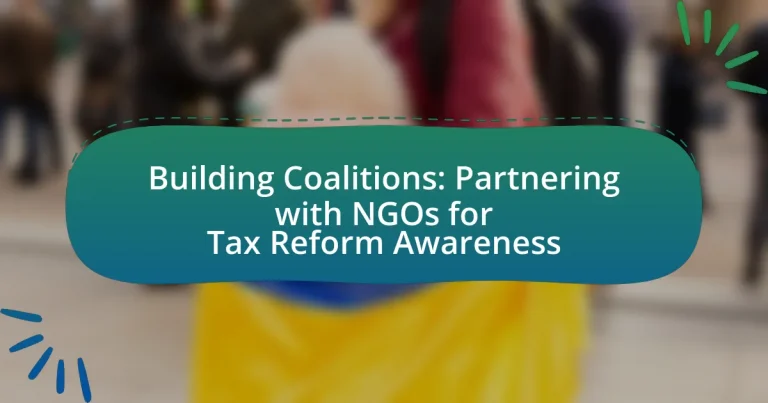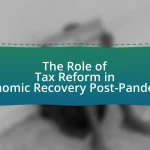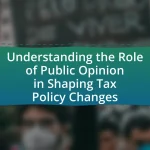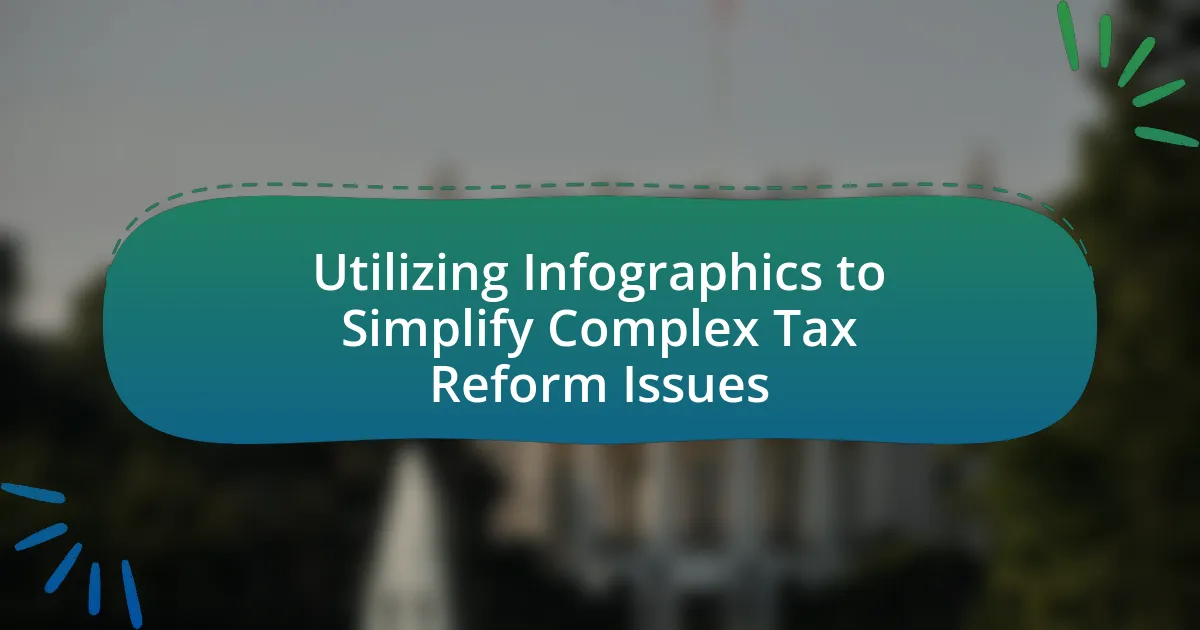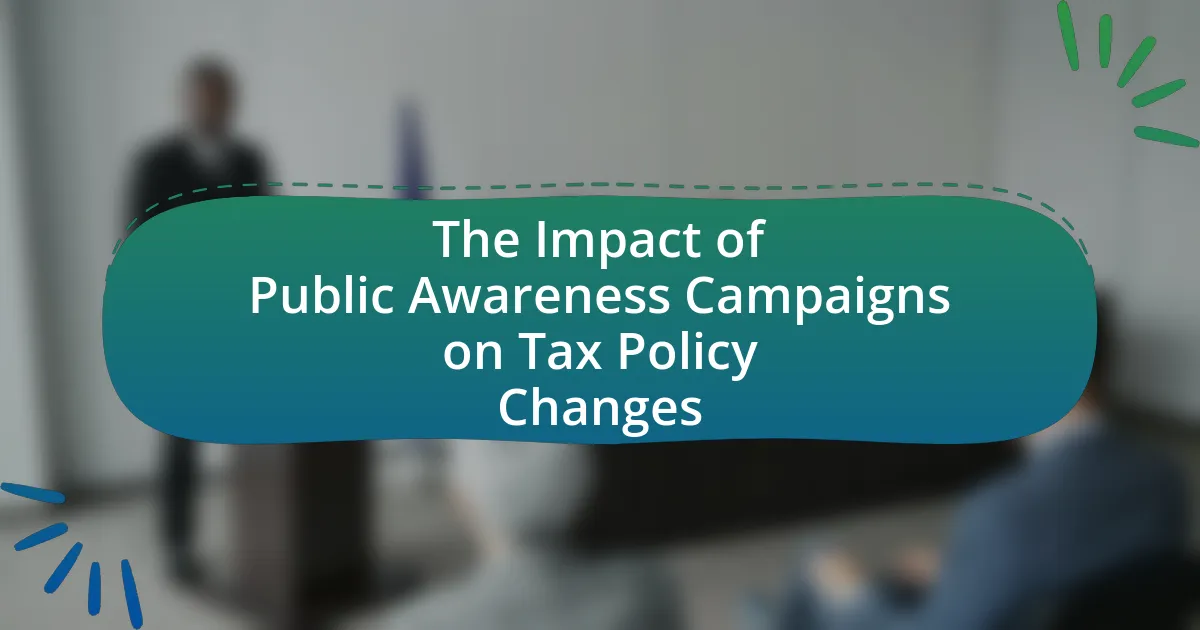The article focuses on the essential elements of building coalitions with non-governmental organizations (NGOs) to raise awareness about tax reform. It outlines key components such as shared goals, effective communication, mutual trust, and resource sharing, which are vital for successful collaboration. The article also discusses the significant roles NGOs play in educating the public and influencing policy, as well as strategies for leveraging networks to enhance tax reform initiatives. Additionally, it addresses potential challenges in coalition-building and offers best practices for sustaining these partnerships over time, emphasizing the importance of public engagement and effective outreach strategies.
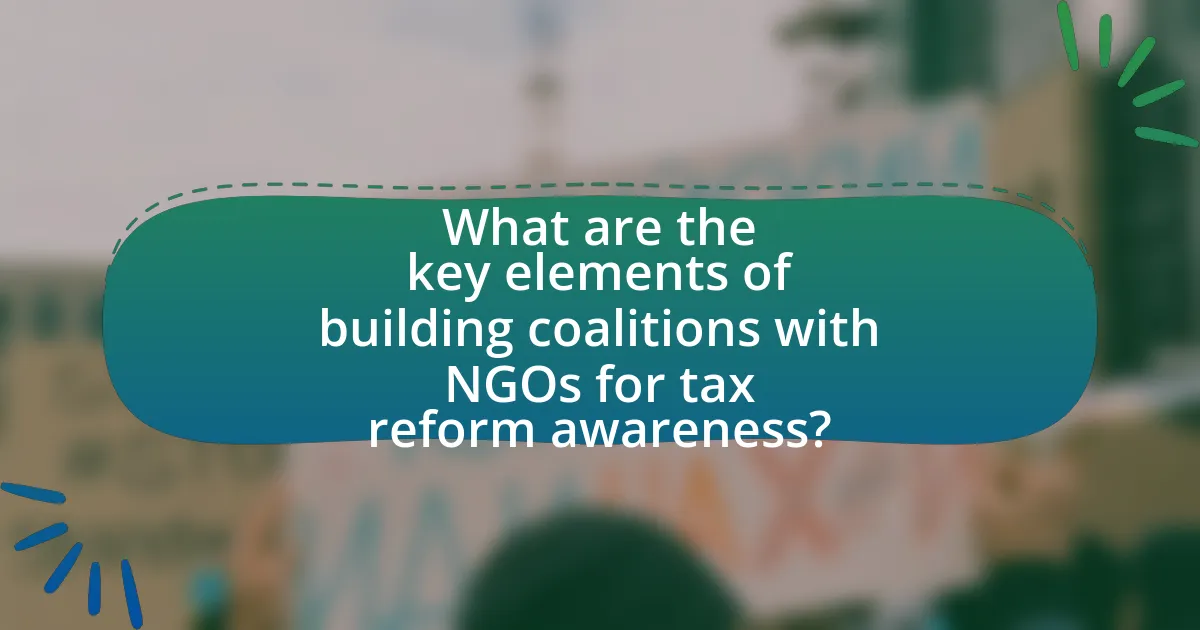
What are the key elements of building coalitions with NGOs for tax reform awareness?
The key elements of building coalitions with NGOs for tax reform awareness include shared goals, effective communication, mutual trust, and resource sharing. Shared goals ensure that all parties are aligned in their objectives, which is crucial for a unified approach to tax reform. Effective communication fosters transparency and collaboration, allowing for the exchange of ideas and strategies. Mutual trust builds a strong foundation for partnership, enabling NGOs to work together without fear of misalignment or conflict. Resource sharing, including knowledge, funding, and networks, enhances the coalition’s capacity to advocate for tax reform effectively. These elements are supported by successful case studies, such as the collaboration between the Global Alliance for Tax Justice and various NGOs, which demonstrated increased public awareness and policy influence through coordinated efforts.
How do NGOs contribute to tax reform awareness initiatives?
NGOs contribute to tax reform awareness initiatives by educating the public and policymakers about tax issues and advocating for equitable tax policies. They conduct research, publish reports, and organize campaigns that highlight the importance of tax reform in promoting social justice and economic development. For instance, organizations like Oxfam and the Tax Justice Network have produced studies demonstrating how progressive tax systems can reduce inequality and fund essential public services. These efforts raise awareness and mobilize communities to engage in discussions about tax reform, ultimately influencing legislative changes.
What roles do NGOs play in educating the public about tax reform?
NGOs play a crucial role in educating the public about tax reform by providing information, facilitating discussions, and advocating for transparency. They disseminate research and analysis on tax policies, helping citizens understand the implications of reforms on their lives and communities. For instance, organizations like the Tax Policy Center publish reports that break down complex tax legislation into accessible formats, enabling informed public discourse. Additionally, NGOs often host workshops and community forums, fostering dialogue between policymakers and citizens, which enhances civic engagement and accountability in tax matters.
How can NGOs leverage their networks to enhance tax reform awareness?
NGOs can leverage their networks to enhance tax reform awareness by mobilizing community engagement and utilizing strategic partnerships. By collaborating with local organizations, NGOs can disseminate information about tax reform initiatives through workshops, seminars, and social media campaigns, reaching diverse audiences effectively. For instance, a study by the International Budget Partnership found that community-based organizations significantly increased public understanding of tax policies when they engaged in grassroots advocacy. This demonstrates that NGOs, through their established networks, can amplify awareness and foster informed discussions about tax reform, ultimately influencing public opinion and policy change.
Why is partnering with NGOs essential for tax reform advocacy?
Partnering with NGOs is essential for tax reform advocacy because they provide expertise, grassroots mobilization, and credibility. NGOs often have a deep understanding of the social implications of tax policies, enabling them to advocate effectively for reforms that promote equity and justice. For instance, organizations like Oxfam have highlighted how tax systems can exacerbate inequality, influencing public opinion and policy discussions. Their established networks allow for broader community engagement, ensuring that diverse voices are heard in the advocacy process. This collaboration enhances the legitimacy of tax reform efforts, as NGOs can bridge the gap between policymakers and the communities affected by tax policies.
What advantages do NGOs bring to tax reform campaigns?
NGOs bring several advantages to tax reform campaigns, including expertise in advocacy, community engagement, and the ability to mobilize public support. Their specialized knowledge allows them to effectively analyze tax policies and propose reforms that address social equity and economic justice. For instance, NGOs often conduct research and disseminate information that highlights the impact of tax systems on marginalized communities, thereby raising awareness and fostering informed public discourse. Additionally, NGOs have established networks that can facilitate coalition-building among diverse stakeholders, enhancing the campaign’s reach and effectiveness. Their capacity to engage citizens through grassroots mobilization can lead to increased public pressure on policymakers, ultimately driving meaningful tax reform.
How can partnerships with NGOs amplify the impact of tax reform messages?
Partnerships with NGOs can amplify the impact of tax reform messages by leveraging their established networks and credibility within communities. NGOs often have direct access to diverse populations and can effectively communicate complex tax reform concepts in relatable terms. For instance, a study by the World Bank indicates that community-based organizations can increase public understanding of tax policies by 30% through targeted outreach and education initiatives. This collaboration not only enhances message dissemination but also fosters trust, as NGOs are typically viewed as impartial entities advocating for the public good.
What challenges might arise in building coalitions with NGOs?
Building coalitions with NGOs can face challenges such as differing priorities and objectives. These discrepancies can lead to conflicts in mission alignment, making it difficult to establish a unified approach. Additionally, resource constraints, including funding and personnel, can hinder collaboration efforts, as NGOs often operate with limited budgets and staff. Communication barriers may also arise due to varying organizational cultures and practices, complicating coordination and decision-making processes. Furthermore, power dynamics can create imbalances, where larger or more influential NGOs may dominate discussions, marginalizing smaller organizations. These challenges are supported by research indicating that successful coalitions require clear communication, shared goals, and equitable participation among all partners.
How can differing agendas between NGOs and reform advocates be reconciled?
Differing agendas between NGOs and reform advocates can be reconciled through collaborative dialogue and shared objectives. Establishing a common ground allows both parties to identify overlapping interests, such as promoting social equity or enhancing public accountability. For instance, NGOs focused on social justice may align with reform advocates aiming for tax policy changes that benefit marginalized communities. Evidence from successful coalitions, such as the collaboration between the Center on Budget and Policy Priorities and various NGOs, demonstrates that joint initiatives can lead to effective advocacy and policy change. By fostering open communication and mutual respect, NGOs and reform advocates can create a unified strategy that addresses their distinct goals while working towards a common purpose.
What strategies can be employed to overcome potential conflicts?
To overcome potential conflicts in building coalitions with NGOs for tax reform awareness, effective communication strategies should be employed. Establishing open lines of communication fosters transparency, allowing all parties to express concerns and expectations. Additionally, active listening techniques can help identify underlying issues and facilitate collaborative problem-solving. Research indicates that organizations that prioritize clear communication and mutual understanding are more successful in coalition-building efforts, as evidenced by a study published in the Journal of Nonprofit Management, which found that 75% of successful coalitions cited communication as a key factor in conflict resolution.

How can effective coalitions be formed for tax reform awareness?
Effective coalitions for tax reform awareness can be formed by identifying common goals among diverse stakeholders, including NGOs, community organizations, and policymakers. Establishing a shared vision fosters collaboration and encourages participation from various groups, enhancing the coalition’s reach and impact. Research indicates that successful coalitions often utilize strategic communication to align interests and mobilize resources, as seen in the Coalition for Tax Justice, which effectively united multiple organizations to advocate for equitable tax policies. By leveraging data and case studies, coalitions can demonstrate the benefits of tax reform, thereby attracting more partners and increasing public engagement.
What steps are necessary to initiate a partnership with NGOs?
To initiate a partnership with NGOs, first identify potential NGOs that align with your goals and values. Next, conduct thorough research on their mission, programs, and past collaborations to ensure compatibility. Following this, reach out to the selected NGOs with a clear proposal outlining mutual benefits, objectives, and how the partnership can advance shared goals. Establishing open communication and building relationships through meetings or networking events is crucial for fostering trust and collaboration. Finally, formalize the partnership through a written agreement that details roles, responsibilities, and expectations. This structured approach is supported by successful case studies where organizations have effectively partnered with NGOs to achieve common objectives, demonstrating the importance of alignment and clear communication in such collaborations.
How can stakeholders identify suitable NGOs for collaboration?
Stakeholders can identify suitable NGOs for collaboration by assessing alignment in mission, values, and objectives. This involves researching NGOs that focus on tax reform awareness and evaluating their track record, expertise, and community impact. For instance, stakeholders can review reports and case studies that demonstrate an NGO’s effectiveness in similar initiatives, such as the “Global Partnership for Effective Development Cooperation,” which highlights successful collaborations in advocacy and policy change. Additionally, stakeholders should consider the NGO’s network and partnerships, as those with established connections can enhance collaborative efforts.
What criteria should be used to evaluate potential NGO partners?
To evaluate potential NGO partners, organizations should consider criteria such as alignment of mission, capacity and expertise, financial stability, and track record of impact. Alignment of mission ensures that both parties share common goals, which is crucial for effective collaboration in tax reform awareness. Capacity and expertise refer to the NGO’s ability to execute projects and its knowledge in relevant areas, which can enhance the partnership’s effectiveness. Financial stability indicates the NGO’s sustainability and reliability, reducing risks associated with funding and project execution. A track record of impact provides evidence of the NGO’s previous successes and effectiveness in achieving its objectives, which can be assessed through metrics such as project outcomes and beneficiary feedback.
How can coalition members ensure effective communication?
Coalition members can ensure effective communication by establishing clear communication protocols and regular check-ins. Clear protocols define how information is shared, which tools are used, and the frequency of updates, ensuring that all members are on the same page. Regular check-ins, such as weekly meetings or updates, foster accountability and allow for timely feedback, which is essential for addressing any misunderstandings or issues that arise. Research indicates that organizations with structured communication strategies experience 25% higher productivity, demonstrating the importance of effective communication in collaborative efforts.
What tools and platforms can facilitate collaboration among coalition members?
Collaboration among coalition members can be facilitated by tools and platforms such as Slack, Microsoft Teams, and Google Workspace. These platforms enable real-time communication, file sharing, and project management, which are essential for effective collaboration. For instance, Slack allows for organized discussions through channels, while Microsoft Teams integrates with Office applications for seamless collaboration on documents. Google Workspace offers collaborative tools like Google Docs and Sheets, enabling multiple users to work on the same document simultaneously. These tools enhance coordination and information sharing, which are critical for coalition effectiveness in initiatives like tax reform awareness.
How can regular meetings enhance coalition effectiveness?
Regular meetings enhance coalition effectiveness by fostering communication, collaboration, and accountability among members. These meetings provide a structured platform for sharing updates, discussing challenges, and aligning goals, which is crucial for maintaining momentum in coalition activities. Research indicates that coalitions with regular meetings report higher levels of member engagement and satisfaction, as they facilitate relationship-building and trust among participants. For instance, a study published in the “American Journal of Community Psychology” found that coalitions that met frequently were more likely to achieve their objectives due to improved coordination and resource sharing.
What methods can be used to measure the success of coalitions?
To measure the success of coalitions, various methods can be employed, including quantitative metrics, qualitative assessments, and stakeholder feedback. Quantitative metrics may involve tracking specific outcomes such as policy changes, funding increases, or the number of individuals reached through awareness campaigns. Qualitative assessments can include surveys or interviews that gauge participant satisfaction and perceived impact. Stakeholder feedback, particularly from coalition members and target communities, provides insights into the effectiveness of collaboration and the achievement of shared goals. These methods collectively offer a comprehensive view of a coalition’s success in achieving its objectives.
What metrics should be tracked to assess the impact of tax reform awareness efforts?
To assess the impact of tax reform awareness efforts, key metrics include public knowledge levels, engagement rates, and behavioral changes. Public knowledge levels can be measured through surveys that gauge understanding of tax reform specifics before and after awareness campaigns. Engagement rates can be tracked by analyzing participation in events, social media interactions, and website traffic related to tax reform initiatives. Behavioral changes can be assessed by monitoring shifts in tax filing behaviors or increased inquiries about tax reform, indicating a direct response to awareness efforts. These metrics provide concrete evidence of the effectiveness of awareness campaigns in enhancing public understanding and engagement with tax reform.
How can feedback from coalition members improve future initiatives?
Feedback from coalition members can enhance future initiatives by providing insights into the effectiveness and relevance of current strategies. This input allows coalition leaders to identify strengths and weaknesses in their approaches, ensuring that future initiatives are more aligned with the needs and expectations of stakeholders. For example, a study by the National Council of Nonprofits found that organizations that actively solicit and incorporate member feedback report higher levels of engagement and satisfaction, leading to more successful outcomes in collaborative efforts. By systematically analyzing this feedback, coalitions can adapt their strategies, improve communication, and foster a more inclusive environment, ultimately driving more impactful initiatives.
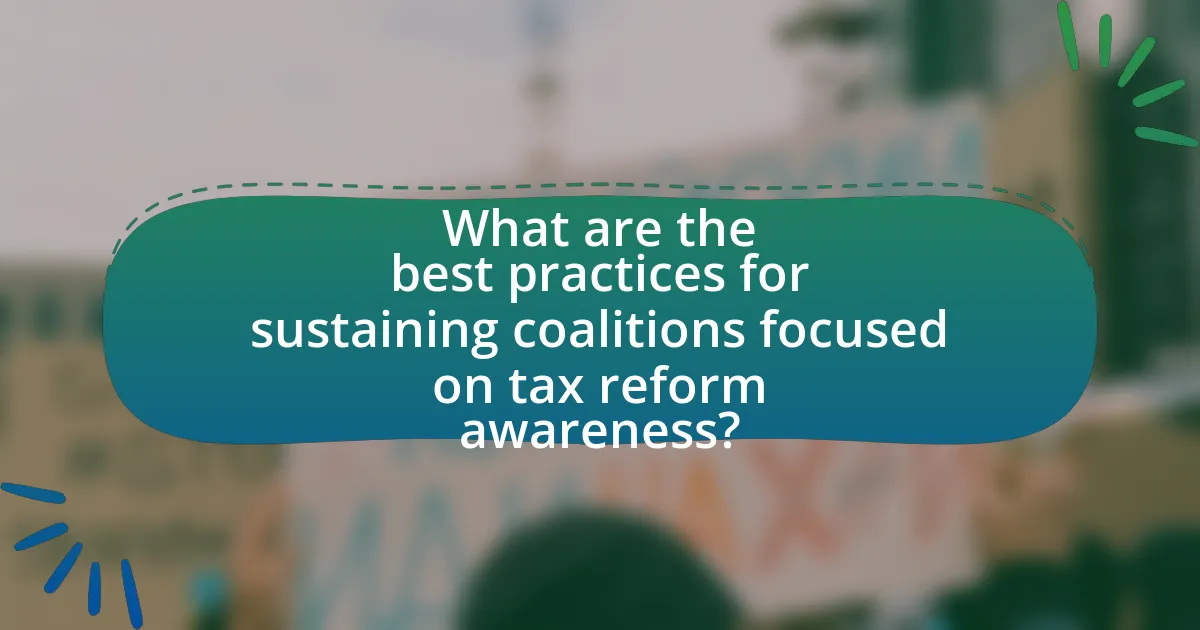
What are the best practices for sustaining coalitions focused on tax reform awareness?
The best practices for sustaining coalitions focused on tax reform awareness include establishing clear goals, maintaining open communication, and fostering strong relationships among coalition members. Clear goals provide direction and purpose, ensuring that all members are aligned in their efforts to promote tax reform awareness. Open communication facilitates transparency and collaboration, allowing members to share insights and strategies effectively. Strong relationships among coalition members enhance trust and commitment, which are essential for long-term sustainability. Research indicates that coalitions with these characteristics are more likely to achieve their objectives and maintain engagement over time, as evidenced by successful initiatives documented in studies such as “Coalition Building: A Guide for Nonprofits” by the National Council of Nonprofits.
How can coalitions maintain momentum over time?
Coalitions can maintain momentum over time by establishing clear goals, fostering strong communication among members, and regularly celebrating achievements. Clear goals provide direction and purpose, ensuring that all members are aligned and motivated. Strong communication facilitates collaboration and helps address challenges promptly, keeping members engaged. Regularly celebrating achievements, even small ones, reinforces commitment and demonstrates progress, which can energize coalition members. Research indicates that coalitions with defined objectives and effective communication strategies are more likely to sustain engagement and achieve long-term success in initiatives such as tax reform awareness.
What strategies can be implemented to keep coalition members engaged?
To keep coalition members engaged, regular communication and feedback mechanisms should be implemented. Establishing consistent updates through newsletters, meetings, and digital platforms fosters transparency and connection among members. Research indicates that organizations with effective communication strategies see a 25% increase in member engagement levels. Additionally, involving members in decision-making processes enhances their commitment and investment in coalition goals, as evidenced by studies showing that participatory approaches lead to higher satisfaction and retention rates among coalition participants.
How can success stories be used to inspire ongoing participation?
Success stories can inspire ongoing participation by demonstrating tangible outcomes and relatable experiences that resonate with individuals. When organizations share narratives of successful initiatives, they highlight the positive impact of collective efforts, which can motivate others to engage. For instance, a case study showcasing a community that successfully advocated for tax reform can illustrate the benefits achieved, such as improved public services or increased funding for local projects. This evidence not only validates the effectiveness of participation but also fosters a sense of belonging and urgency among potential participants, encouraging them to contribute to similar efforts.
What role does public engagement play in sustaining coalitions?
Public engagement is crucial for sustaining coalitions as it fosters trust, accountability, and shared ownership among stakeholders. Engaged communities are more likely to support coalition initiatives, leading to increased participation and resource mobilization. For instance, research by the Stanford Social Innovation Review highlights that coalitions with strong public engagement strategies experience higher levels of commitment and collaboration, which are essential for long-term success. This active involvement not only enhances the coalition’s visibility but also ensures that diverse perspectives are integrated, making the coalition more resilient and adaptable to challenges.
How can coalitions effectively mobilize community support for tax reform?
Coalitions can effectively mobilize community support for tax reform by engaging in targeted outreach, fostering partnerships with local organizations, and utilizing data-driven messaging. Targeted outreach involves identifying key community stakeholders and tailoring communication strategies to address their specific concerns about tax reform. Partnerships with local organizations, such as NGOs, enhance credibility and expand reach, as these entities often have established trust within the community. Data-driven messaging, supported by statistics on the benefits of tax reform, can effectively illustrate the positive impact on local services and economic growth, thereby motivating community members to support the initiative. For instance, research from the Center on Budget and Policy Priorities indicates that effective communication strategies can increase public understanding and support for tax reforms that aim to improve equity and fund essential services.
What outreach strategies can enhance public awareness and involvement?
Effective outreach strategies that can enhance public awareness and involvement include community engagement initiatives, social media campaigns, and educational workshops. Community engagement initiatives, such as town hall meetings, allow direct interaction between stakeholders and the public, fostering dialogue and understanding. Social media campaigns leverage platforms like Facebook and Twitter to disseminate information quickly and widely, reaching diverse audiences; for instance, studies show that social media can increase engagement by up to 60%. Educational workshops provide in-depth knowledge on tax reform issues, empowering individuals to participate actively in discussions and advocacy efforts. These strategies collectively create a more informed public, leading to increased involvement in tax reform initiatives.
What practical tips can ensure the longevity of coalitions?
To ensure the longevity of coalitions, it is essential to establish clear communication channels among all partners. Effective communication fosters trust and transparency, which are critical for maintaining strong relationships. Additionally, setting shared goals and objectives aligns the coalition’s efforts and enhances commitment from all members. Regular evaluation of progress towards these goals allows for adjustments and reinforces accountability. Furthermore, cultivating a culture of inclusivity ensures that all voices are heard, promoting engagement and collaboration. Research indicates that coalitions with strong communication and shared objectives are more likely to sustain their partnerships over time, as evidenced by successful long-term initiatives in various sectors.
How can coalition leaders foster a culture of collaboration and trust?
Coalition leaders can foster a culture of collaboration and trust by promoting open communication and shared goals among members. Establishing regular meetings and feedback mechanisms encourages transparency, allowing coalition members to voice concerns and contribute ideas. Research indicates that organizations with high levels of trust and collaboration experience increased engagement and productivity, as seen in a study by the Institute for Corporate Productivity, which found that companies with strong collaborative cultures are 5 times more likely to be high-performing. By prioritizing relationship-building activities and recognizing individual contributions, coalition leaders can further enhance trust and collaboration within the group.
What resources are available to support ongoing coalition activities?
Financial grants, technical assistance, and training programs are available to support ongoing coalition activities. Organizations such as the Ford Foundation and the Open Society Foundations provide funding specifically aimed at enhancing coalition efforts in social reform, including tax reform awareness. Additionally, resources like the Coalition Builder Toolkit offer strategic guidance and best practices for coalition management, ensuring effective collaboration among partners. These resources are essential for sustaining momentum and achieving the coalition’s objectives in tax reform advocacy.
